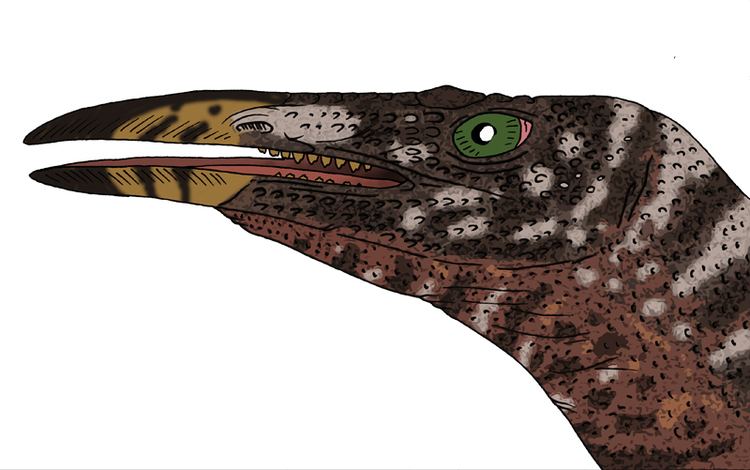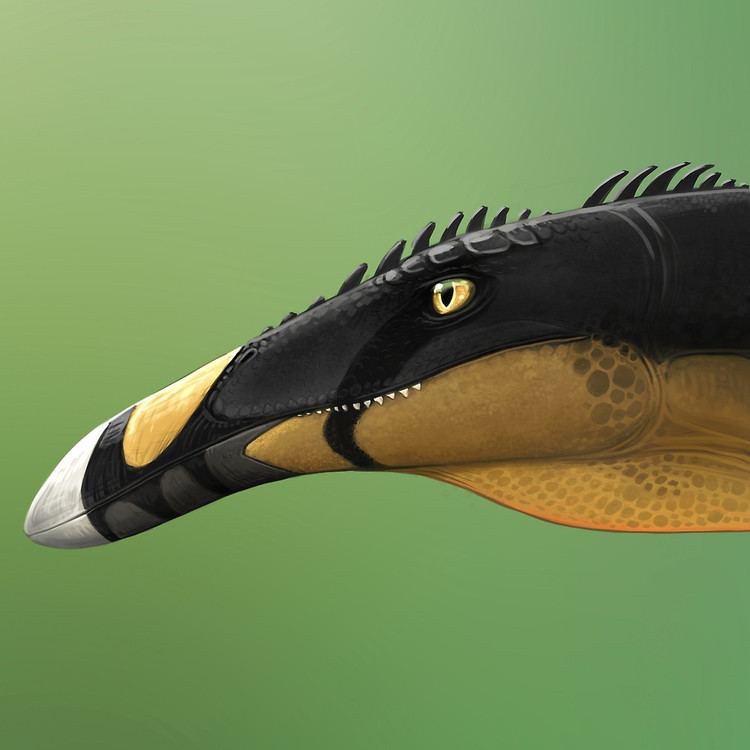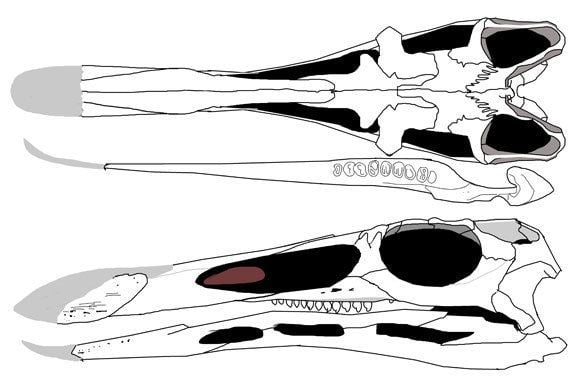Phylum Chordata | Class Reptilia Order Trilophosauridae | |
 | ||
Genus †TeraterpetonSues, 2003 Similar Trilophosaurus, Pamelaria, Spinosuchus, Mesosuchus | ||
Teraterpeton (meaning "wonderful creeping thing" in Greek) is an extinct genus of trilophosaurid archosauromorph. A partial skeleton was described from the Late Triassic Wolfville Formation of Nova Scotia in 2003. It has many unique features seen in no other related form, including an elongated, toothless snout and large openings for the nostrils. Because of this, Teraterpeton was originally placed in its own family, Teraterpetidae, however it's now considered to be a member of Trilophosauridae.
Contents

Description

Teraterpeton has a very different appearance from other early archosauromorphs. It has a long skull with no teeth at the ends of the upper and lower jaws. Over the eye sockets, two bony projections are formed by the lacrimal and prefrontal bones. At the back of the jaws, the small, sharp teeth are closely spaced. They continue below the level of the eye, an unusual trait among early archosauromorphs. The upper tooth row does not run along the edge of the jaw, but is inset closer to mouth. An additional tooth row on the palate runs alongside the maxillary tooth row of the upper jaw. The teeth of the upper jaws fit closely, or occlude, with the teeth of the lower jaw. The upper jaw teeth have sharp cusps with indentations in front of them, while the lower jaw teeth have cusps with indentations behind them. The cusps of the upper teeth fit into the indentations of the lower teeth, while the cusps of the lower teeth fit into the indentations of the upper teeth.

Teraterpeton is unique among all archosauromorphs in having a euryapsid-type skull. Euryapsids have a single hole at the back of the skull called the supratemporal fenestra, which is located toward the top of the head. Teraterpeton evolved from diapsid reptiles with two holes at the back of their skull, the supratemporal fenestra and an infratemporal fenestra below it. Although it lacks an infratemporal fenestra, Teraterpeton still belongs to Diapsida because it is a descendant of true diapsids. Other euryapsids such as the marine plesiosaurs and ichthyosaurs are not closely related to Teraterpeton.

Another unusual feature of Teraterpeton is the large size of its narial fenestra, a hole in the skull that serves as the opening for the nostril. This hole is positioned directly in front of the eyes and extends to the level of the toothless portion of the snout. It is positioned where the antorbital fenestra would normally be. In fact, the namer of Teraterpeton first considered the hole to be an antorbital fenestra. The anterior margin of the antorbital fenestra is usually bound by the maxilla near the end of the snout and the lacrimal near the eye socket. However, the maxilla of Teraterpeton has moved closer to the eye socket, touching the lacrimal and closing off the antorbital fenestra. Comparable in size to the antorbital fenestrae of many other archosauromorphs, the narial fenestra of Teraterpeton is even longer than the eye socket.
History

Teraterpeton is known from a single partial holotype skeleton referred to as NSM 999GF041. This skeleton was found in a sea cliff in Burntcoat Head, Nova Scotia. The deposit from which it was found is part of the late Carnian Wolfville Formation, comprising a section of the larger Newark Supergroup that stretches across Canada and the eastern United States. The formation is located in the Fundy Basin, a rift basin which, like other Newark basins, opened as Pangaea began to break apart at the end of the Triassic. The Wolfville Formation contains a diverse assemblage of Triassic tetrapods that includes temnospondyl amphibians, procolophonid reptiles, and traversodont cynodonts. Based on the presence of the temnospondyl Koskinonodon (a common Triassic index fossil), the assemblage is dated to the Carnian stage of the Late Triassic.

The type species of Teraterpeton, T. hrynewichorum, was named in 2003. It is named after George P. Hrynewich and his son Sandy Hrynewich, fossil collectors who discovered the bones at Burntcoat Head in 1999.
Classification

A phylogenetic analysis was provided in the original description of Teraterpeton in 2003. It placed Trilophosaurus as the closest relative of the genus. Together, these two forms comprise an archosauromorph clade that is more derived than protorosaurians and more basal than rhynchosaurs. Below is a cladogram modified from the 2003 analysis:
